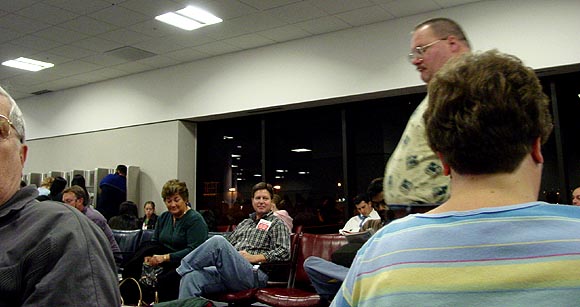View current page
...more recent posts
Fuzzy think piece in the NY Times today here on the Tsunami and what it all means. A good discussion of how cataclysmic seismic events seem to come in clusters lies sandwiched between the contentious headline "The Year the Earth Fought Back" and some spurious riffing on the Gaia hypothesis, which holds that the entire world is a living organism.
The key word there is "living." To imply that the molten rock under our feet is an active (as in volitional) part of Gaia takes us a bit further back into animist mysticism than most of us should want to go. In other words, the headline and thesis might be intuitive if 100,000 had died as a result of disease or sudden release of organic chemicals into the air. That could indeed suggest that Gaia has "fought back" against our sloppy stewardship of her--that she is self-regulating to correct damage one of her component species causes.
Yet surely if Gaia exists it is in the community of living matter hugging an inhospitable ball of nickel-iron like a skin, not the ball itself. The ball's mistreatment of the skin may very well come in peristaltic spurts of volcanos and earthquakes, but the skin adjusts to that over the eons. Rock responds to the biosphere, too, of course, but lightly, in the form of erosion. To say that the biosphere sent a signal to the rocks to deform themselves and punish mankind is Old Testament hogwash--turning a nurturing mother back into the man with the spear.
More Damned Metablogging
Many thanks to Raphael Rubinstein for his nice piece on art blogs in the January 2005 Art in America, and for tossing this page into the mix. Dan at Iconoduel, another tossee, posted searchable text here, and still another, Joy Garnett at NEWSgrist, put up a scan. Garnett related the AinA piece to the recent Rhizome.org panel on art blogs I and other bloggers participated in, and also a research paper titled "Art Blogs: Why Such a Timid Emergence?" by Marie Omann, a masters degree student in Design, Communication and Media at the IT University of Copenhagen, which is published in .PDF form on T.Whid's and M.River's blog.
The panel and the paper tended to concentrate on how practicing artists use blogs, while Rubinstein focused more on the growing field of blog-style art journalism. Omann imposed especially tight criteria for her research subjects, requiring that the blogs be written by artists in their role as artists, have artistic content, and be updated daily. She then triangulated this activity within current sociological and media theory about the internet and its budding communities.
In brief, Omann mostly shrugs off the old-school Marxist view of Modernity as a community-destroying blight and posits art blogs as an example of "liberated communities," that is, "sparsely knit and territorially unbound communities based on individual choices." (Think fan clubs and terrorist cells.) Before the Internet, these "geographically dispersed social networks" already existed in our highly mobile, wired society--even participation in a biological family unit is increasingly seen as voluntary when its members live in different cities.
As for how well blogging fits into all this, let's just say my two cents were quoted at length so of course I think her arguments are great. But as I told Omann in a thank you email, she possibly oversold the idea of community within the world of visual art online self-publishing. Fault lines exist within this global village that are actually gaping, sulphurous chasms patched over with hopeful cyber-cement. Here are just a few of the divisions:
Print journalism (and its online variants) vs blogs. A subject of endless, mostly angry fascination among the art-journo-bloggers, and while Rubinstein has extended the olive branch of reciprocal fascination, it should probably be greeted with haughty skepticism. Just kidding, of course.
New York vs everywhere else. Another subject of endless fascination outside New York, but tedious to read. The discourse needs to rise above the level of lame us vs them conspiracy theories.
Artists vs non-artists. Shop talk steers the bus but others are welcome to listen in and back seat drive, assuming that's OK with James Elkins.
Gallery art vs new media art. Can anyone argue across this divide? Will the former please pay attention to the latter and will the latter please stop obsessing about not being paid attention to?
Blogging about art vs other stuff. It's silly to limit yourself to one subject in a medium that can tie you into any discourse at the click of a hyperlink.
This page promises to work hard to widen all these nascent, still largely unspoken rifts within the so-called community of so-called art blogs. In a friendly way.
Update: edited slightly to clarify that "NY vs Everywhere Else" whining is tedious universally, not just to New Yorkers. I hated it long before I lived here.


Atlanta airport, December 23, 2004. Delta flight took off 5 1/2 hours later than scheduled.
More impressions of the "Scratch Code" exhibition at bitforms, presenting computer art from the '50s, '60s and '70s. Paul asks about the Peter Vogel sculpture: I'd say its appeal is more technological than artistic--or perhaps, it's better as sound art than visual art. This gets back to an earlier post about circuit bent work being problematic as sculpture. The best work looks like it emerges casually and offhandedly as a result of a technologist trying to create a certain set of sounds, that is, as sloppy mad scientist bricolage, but as soon as it becomes self-consciously "artistic" or "sculpture-like" it loses, um, juice. Vogel has made a little cage of soldered metal sticks holding wires, capacitors, transistors, etc that cheeps and bleeps as you move around it. All the circuitry is exposed and you can visualize a certain set of probabilistic variables creating that sound even if you know nothing about electronics. The sounds are fascinating but the sculpture has to stand next to say, David Smith, who kind of set the standard for freestanding modernist sculpture, and it rather ignores all his hard work and the dialogue he participated in in favor of "making shit up"--i.e., presenting an unengaging, upright column-shape with the spidery, solder-y metallic textures of modernist knockoff mall art, or church or synagogue art. You can enjoy it on that level but you have to view it with kitsch filters firmly in place.
Manfred Mohr's prints in the same show, however, seem neither cheesy nor dated, perhaps because they are Ultimately Minimal and not trying to be expressive. They speak purely and eloquently to a techno-design-acclimated generation conversant with the likes of Designers Republic CD covers; they could also be cool scores for music by glitch-and-hiss musicians. Carsten Nicolai's spare, scrupulous visual work also comes to mind.
I hope that when I'm in my 70s I won't be haranguing bloggers (or whoever replaces them in the communication food chain) by saying "I was the first artist to make paper quilts with computer output!" or whatever. Just got a comment from Manfred Mohr, who wishes the record to reflect that he used the "incomplete open cube" before Sol LeWitt did and is mad that I said he "copped" it from LeWitt, in my discussion of the "Scratch Code" show at bitforms. He seems to have missed that my review was complimenting his work. His peevish comment and my petulant reply are here.
Traveling for the Christmas holidays, as Bill O'Reilly would call them. Got to spend 6 hours in the best place in the world: the Atlanta airport. Plane supposed to depart at 7:22 pm left at 12:40 am. These are pictures from the last swing though this carpeted Valhalla, in 2003. New, similar shots coming soon.

Above, an image by Alex Wilson, from a page presenting his last 24 years of Christmas Cards. Moving from pagan to secular idolatry, Alex also found this photo of the Joe Louis Memorial in Detroit, which I would characterize as "Giacometti meets Diego Rivera meets Sun Ra":

Plus maybe Dawn of the Dead. I mean, that's a severed arm, right? This is where a little Modernism gets us in trouble.
UPDATE: D'oh, just realized this was by Robert Graham, a sort of classicist-minimalist (or minimalist-classicist) dude who specializes in detached, fetishized bodies and body parts--often of toned young females.
Justin Raimondo tries to make sense of the latest poll results on Bush's Folly:
"For the first time," a Washington Post-ABC News poll shows, "most say the Iraq war was a mistake." Not to worry, however, because "a strong majority of Americans, 58 percent, support keeping military forces in Iraq until 'civil order is restored,' even in the face of continued U.S. casualties. By a slight margin, 48 percent to 44 percent, more voters agreed with Bush's position that the United States is making 'significant progress' toward its goal of establishing democracy in Iraq." But, oh wait: "Yet, by a similar margin, the public believes the United States is not making significant progress toward restoring civil order." To top it all off, 70 percent say the present casualty rate is "unacceptable."So in the face of all this contradictory data, the New York Times sends a reporter out to "talk to America" and sums up the findings in this (online) headline today:
Fighting On Is the Only Option, Americans Say"Fighting on"--what a crock. It's Vietnam all over again. Growing up, I remember well the mantra "We can't pull out of South Vietnam, there will be a bloodbath." Meaning civil war and reprisals, but as it turned out the bloodbath in Vietnam was the one we caused by staying and bombing and defoliating year after year. Iraq is even worse, though, because we out-and-out invaded it. As Raimondo reminds us:
Having bombed the nation's physical and social infrastructure into piles of blood-stained rubble, disbanded the Iraqi military, marginalized the highly educated and secularized Sunni elite and driven them into a destructive and increasingly successful insurgency – we can't leave until we establish the "civil order" destroyed by ourselves to begin with.The "only option" is to pull out our troops and offer financial reparations (and help to refugees) for the havoc we caused. Then impeach Bush for ginning up the phony WMD threat. We're the 800 pound gorilla, we can do whatever we want. Last I heard there was no other global superpower around to "interpret this as a sign of weakness." Terrorism is the price we pay for maintaining 700 military bases around the world after the cold war ended.
